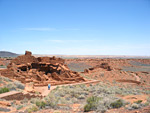I plan on leaving in early May, and am stopping at Tuzigoot, Montezuma Castle and Canyon de Chelly before Chaco, and then going on to El Mapais, El Morro, Petrified Forest, Homolovi, and finally Walnut Canyon before heading home. I am watching the weather closely, trying to avoid rain/snow…. R.
R-
I took a very similar trip to yours a couple of years ago; saw many of the sites you listed. I was stunned by Montezuma’s Castle; see The Well, too, and walk down to the ancient water channel along the stream.
I know how hard it is to see it all, but let me suggest you add Wupatki National Monument, just a little north of Flagstaff, AZ. There is an interesting overlap/collision of features from Anasazi, Hohokam and, maybe, Sinagua. It would add at least a few hours to your trip, but I think you’d like it. It is the most like Chaco in condition and size of ruins. And add Hovenweep National Monument (UT/CO) to your list for future trips.
mjh
 Arizona – Wupatki National Monument
Arizona – Wupatki National Monument
Wupatki National Monument is one of several sites preserving pueblos (houses) of ancient peoples, but unlike the Tonto, Montezuma, Casa Grande and Tuzigoot Monuments where there is only one main building, here there are many ruins scattered over a large area of desert northeast of Flagstaff. The pueblos all have a distinctive red colour and were made from the local Moenkopi sandstone.
Wupatki National Monument (National Park Service)
For its time and place, there was no other pueblo like Wupatki. Less than 800 years ago, it was the tallest, largest, and perhaps the richest and most influential pueblo around. It was home to 85-100 people, and several thousand more lived within a day’s walk. And it was built in one of the lowest, warmest, and driest places on the Colorado Plateau. What compelled people to build here?
Human history here spans at least 10,000 years. But only for a time, in the 1100s, was the landscape this densely populated. The eruption of nearby Sunset Crater Volcano a century earlier probably played a part.




